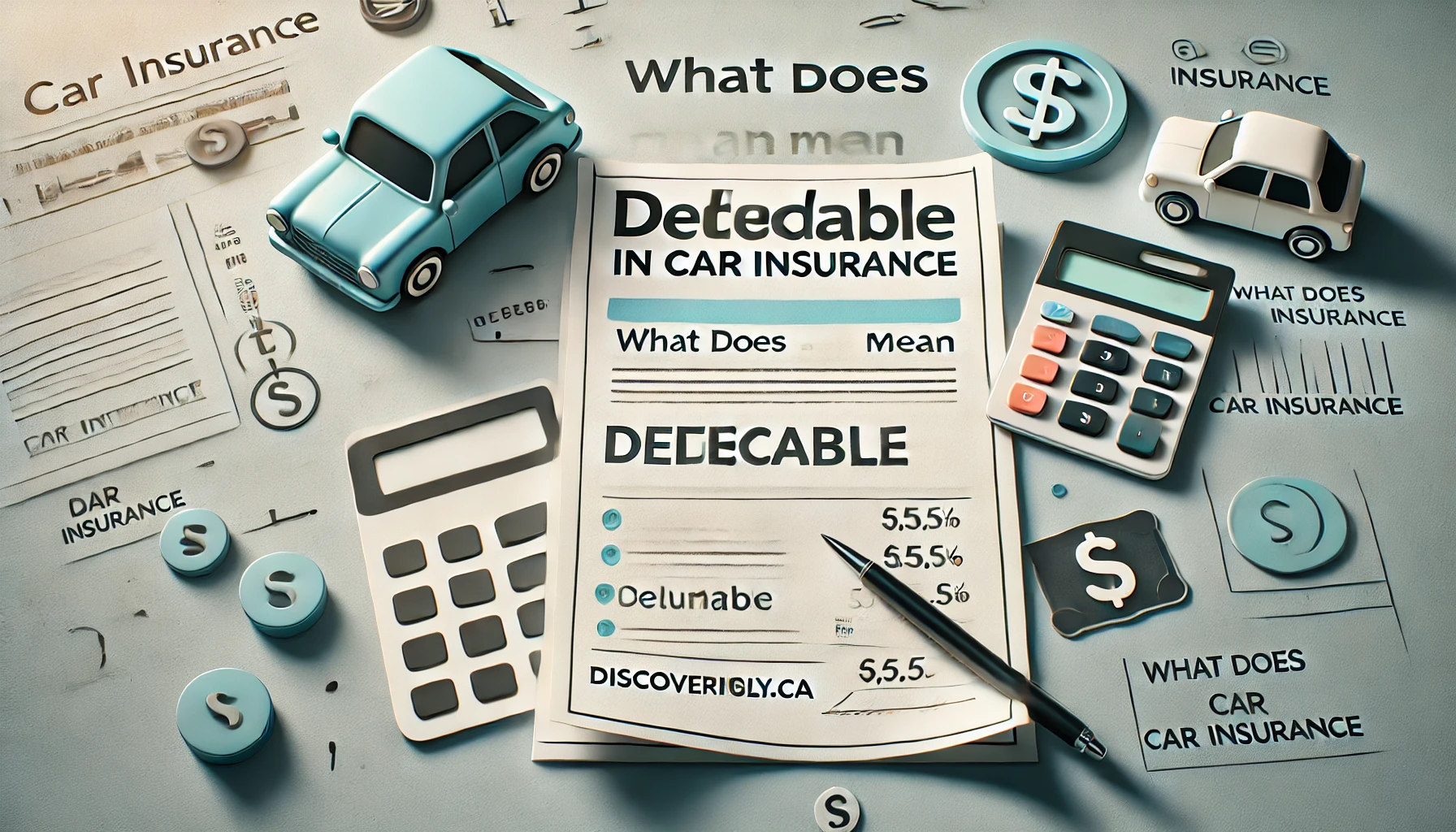What Does Deductible Mean in Car Insurance? Understanding Your Out-of-Pocket Costs
In car insurance, a deductible is the amount of money you agree to pay out of pocket toward the repair or replacement of your vehicle before your insurance coverage kicks in. Essentially, it’s the portion of the financial responsibility that you take on when filing a claim. The deductible amount is chosen when you purchase your insurance policy, and it directly affects both your premium (the amount you pay regularly for coverage) and your out-of-pocket expenses in the event of an accident.
Understanding how deductibles work can help you make informed decisions about your car insurance, balancing monthly premiums with the level of financial protection you need.
How Does a Deductible Work in Car Insurance?
Here’s a step-by-step look at how a deductible works when filing a claim:
- File a Claim: If your car is damaged in an accident or another covered event, you can file a claim with your insurance provider.
- Pay Your Deductible: You pay the deductible amount you agreed to in your policy. For example, if your deductible is $500 and the repair costs are $2,000, you pay the first $500, and your insurer covers the remaining $1,500.
- Insurance Coverage Applies: After you pay the deductible, your insurance covers the rest of the repair or replacement costs up to the policy limits.
Deductibles apply to collision and comprehensive coverage but generally do not apply to liability insurance, which covers damages or injuries to other people or their property.
Types of Deductibles in Car Insurance
Car insurance policies often include two main types of deductibles:
- Collision Deductible: This applies when your car is damaged in an accident, such as hitting another car or an object like a tree or guardrail. Collision deductibles are common in accidents where you’re at fault.
- Comprehensive Deductible: This applies to non-collision incidents, like theft, vandalism, natural disasters, or animal damage (e.g., hitting a deer). Comprehensive deductibles are typically required for damage caused by events outside your control.
Each deductible type has its own separate amount, and choosing different levels for each can offer flexibility in managing both premiums and out-of-pocket expenses.
How Deductible Amounts Affect Car Insurance Premiums
The deductible you choose directly impacts your monthly or annual car insurance premium. Generally:
- Higher Deductible, Lower Premium: Choosing a higher deductible, like $1,000, can lower your premium because you’re accepting more financial responsibility if you file a claim.
- Lower Deductible, Higher Premium: A lower deductible, such as $250 or $500, raises your premium, but you’ll pay less out of pocket in the event of a claim.
For example, if you rarely file claims and want to save on monthly premiums, a higher deductible could be more cost-effective. Conversely, if you prefer lower out-of-pocket expenses when filing a claim, a lower deductible may be a better choice.
Choosing the Right Deductible for Your Needs
When selecting your deductible amount, consider your budget, risk tolerance, and driving habits:
- Budget and Savings: If you can afford to set aside some savings for potential repairs, a higher deductible might help reduce your monthly premiums.
- Risk Tolerance: If you’re comfortable with the possibility of paying more out of pocket, a higher deductible can save you money on your premium. If not, a lower deductible may be safer.
- Driving Frequency: If you drive often or in areas with high accident rates, a lower deductible might be beneficial to minimize your out-of-pocket costs if you need to file a claim.
- Vehicle Age and Value: For older cars with lower market value, a higher deductible may be more economical, as the vehicle’s repair or replacement cost might be lower.
Balancing these factors can help you choose a deductible that aligns with your financial needs and driving circumstances.
When Does a Deductible Apply?
Deductibles are typically applied under certain types of car insurance coverage:
- Collision Claims: Your collision deductible applies if you’re involved in an accident and need repairs covered by your insurance.
- Comprehensive Claims: Your comprehensive deductible applies in cases of damage from events like theft, severe weather, vandalism, or hitting an animal.
- No Deductible for Liability Claims: Deductibles do not apply to liability coverage, which covers damages and injuries to others when you’re at fault. Liability claims are handled fully by your insurer, as they pay for the damages to the other party.
Knowing when a deductible applies can help you understand your potential costs and choose the right type of coverage.
Pros and Cons of High vs. Low Deductibles
High Deductible (e.g., $1,000 or more):
- Pros: Lower premiums; potential for significant monthly savings if you rarely file claims.
- Cons: Higher out-of-pocket costs when filing a claim, which may be a financial burden in the event of a costly accident.
Low Deductible (e.g., $250 to $500):
- Pros: Lower out-of-pocket costs when filing a claim; peace of mind knowing you won’t have to pay a large amount if something happens.
- Cons: Higher premiums, which increase your regular car insurance expenses.
Each deductible level has trade-offs, so it’s important to evaluate which option best aligns with your financial goals and risk tolerance.
Real-Life Examples of Deductibles in Action
Let’s look at two scenarios to see how deductibles work in real life:
- High Deductible Example: You have a $1,000 deductible and get into a minor accident with $1,500 in damage. You’ll pay $1,000 out of pocket, and your insurance will cover the remaining $500.
- Low Deductible Example: You choose a $250 deductible and experience a comprehensive claim due to vandalism costing $1,200 in repairs. You’ll pay the first $250, and insurance covers the remaining $950.
In both cases, the deductible amount affects the total out-of-pocket expense, impacting the overall financial burden.
Tips for Managing Your Deductible
Here are a few tips to make the most of your deductible choice:
- Save for Your Deductible: Consider setting aside money in an emergency fund to cover your deductible if an unexpected accident occurs.
- Evaluate Deductible Options Regularly: As your financial situation changes, it may be worth adjusting your deductible to save on premiums or reduce out-of-pocket risk.
- Drive Safely: Minimizing risk on the road through safe driving habits can reduce the likelihood of filing a claim, making a higher deductible option more cost-effective.
Being prepared for potential out-of-pocket costs ensures that you can comfortably manage your deductible choice.
Conclusion
In car insurance, a deductible is the amount you pay out of pocket when filing a claim before your insurance steps in to cover the remaining costs. Choosing a higher deductible can lower your monthly premium, while a lower deductible reduces your out-of-pocket cost in case of a claim. Striking the right balance between premium savings and deductible costs is essential to managing both your budget and risk level effectively. Understanding deductibles can help you make informed decisions that protect your finances while ensuring sufficient coverage on the road.
Frequently Asked Questions
- What does a deductible mean in car insurance?
- A deductible is the amount you pay out of pocket on a claim before your insurance covers the rest.
- Does a higher deductible mean a lower premium?
- Yes, a higher deductible usually means a lower premium, as you’re agreeing to pay more out of pocket if a claim is filed.
- Do I always pay a deductible on car insurance?
- No, deductibles apply only to certain claims, like collision or comprehensive, and not to liability claims.
- What deductible amount should I choose?
- It depends on your budget, comfort level with out-of-pocket costs, and driving habits. Higher deductibles lower premiums but increase claim costs.
- Can I change my deductible amount?
- Yes, most insurers allow you to adjust your deductible, though this will impact your premium.






